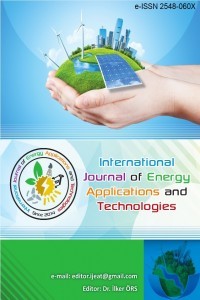A study on the effect of blade inlet angle, attack angle and the diameter ratio on the efficiency of a Banki Mitchell turbine
A study on the effect of blade inlet angle, attack angle and the diameter ratio on the efficiency of a Banki Mitchell turbine
___
- Renewables First. Crossflow Turbines [Online]. 2015. https://www.renewablesfirst.co.uk/hydropower/hydropower-learning-centre/crossflow-turbines/. (25th of May 2021)
- De Andrade, J.; Curiel, C.; Kenyery, F.; Aguillón, O.; Vásquez, A.; Asuaje, M. Numerical investigation of the internal flow in a Banki turbine. Int. J. Rotating Mach. 2011, 2011, 841214.
- Fukutomi J. Senoo Y. and Nakase Y. 1991. Numerical Method of Flow through a Cross-Flow Runner. JSME International Journal: Series II, Vol. 34, No. 1. Japan. pp 44-51.
- Fukutomi J., Nakase Y., Ichimiya M. and Ebisu H. 1995. Unsteady Forces on a Blade in a Cross-Flow Turbine. JSME International Journal: Vol. 38, No. 3. Japan. pp 404-410.
- Yunus A. Çengel and John M. Cimbala; Fluid mechanics: Fundamentals and applications 1st Ed 2006.
- Durgin, WW., and Fay WK. 1984. Some Fluid Characteristics of a Cross Flow Type Hydraulic Turbine. ASME Small Hydropower Fluid Machinery. USES.
- Choi, Y-D., Zhao, L. and Kurokawa, J., 2006. A study on the optimal configuration and performance Improvement of a Micro cross flow hydraulic Turbine. Journal of the Korean Society of Marine Engineering Vol 30. No 2. 2006.
- Mockmore, CA. and Merryfield, F. 1949. The Banki Water Turbine. Engineering Experiment Station. Oregon State College. USES.
- Desai, V. R. and Aziz, N. M., 1994. An Experimental Investigation of cross flow turbine Efficiency. Journal of Fluids Engineering. Vol 116. Pp 545-550 1944.
- Desai VR and Aziz NM, 1991. An Experimental Study of the Effect of Some Design Parameters on Crossflow Turbine Efficiency. Engineering Report. Department of Civil Engineering. Clemson University. USES.
- Yayın Aralığı: Yılda 2 Sayı
- Başlangıç: 2014
- Yayıncı: İlker ÖRS
The influences of gasoline and diesel fuel additive types
Overview a nearly zero energy building
Yousif Mustafa Sadeq AL-KHDHAİRİ, Ahmet Mete VURAL
Ragıp YILDIRIM, Kazım KUMAŞ, Ali Özhan AKYÜZ
Investigation of the improvement of Sivas-Kangal lignites liquefaction product yields
Aydan AKSOĞAN KORKMAZ, İsmail BENTLİ
Solar power plant generation forecasting using NARX neural network model: A case study
